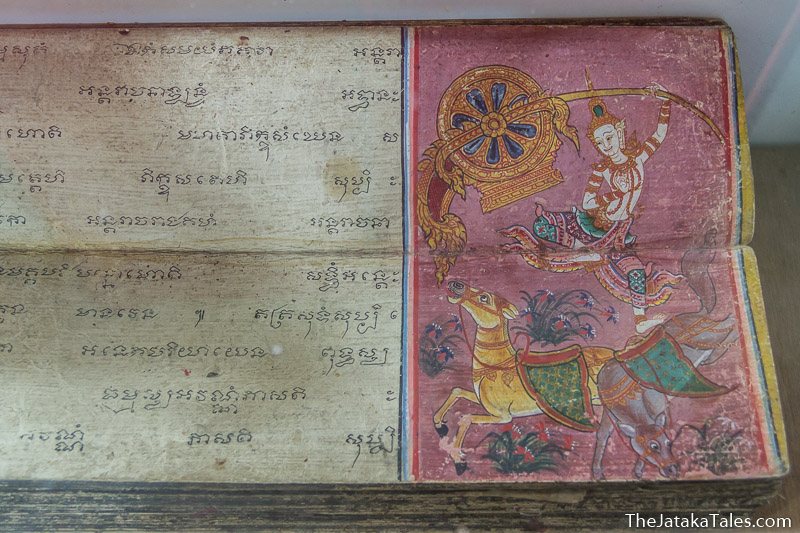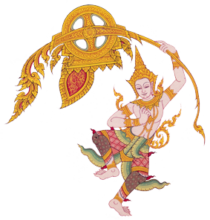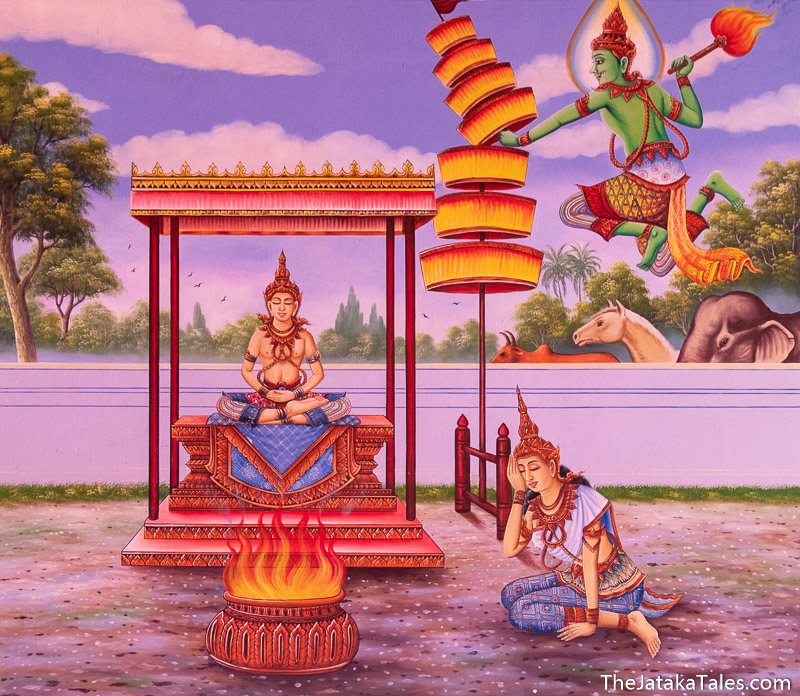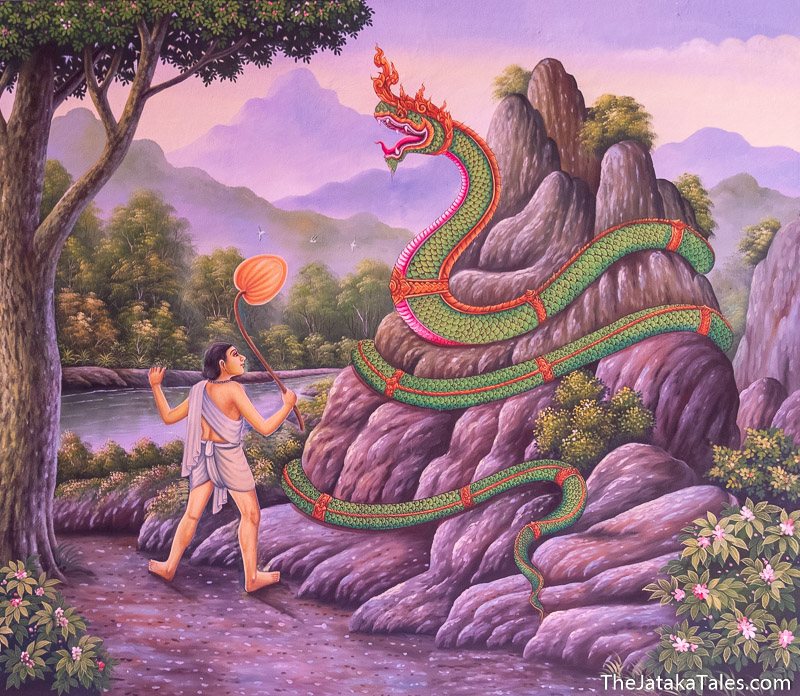The Jataka tales are birth stories from some of the many past lives of the being who would eventually become the Buddha. In them, the Bodhisatta (what a Buddha-to-be is called) is born variously as a human, an animal, and a deity, usually righteous and wise, and frequently with supernatural powers; but often he is just a completely ordinary man. (Here’s a list of his incarnations.) Typically he is the story’s hero, but very often he’s only a minor player, sometimes nothing more than an observer who does nothing.
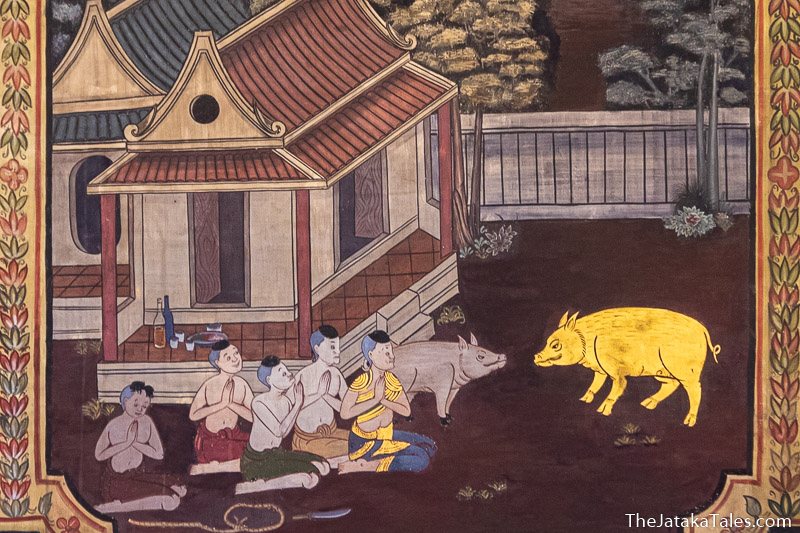
Many of the stories are fun, often with clever twists and humorous events letting the Bodhisatta save the day or overcome a problem or a foe. Most (but far from all) are morality tales, teaching the value of dharma principles like modesty, obedience, or perseverance to the Jataka tales’ two audiences: we the readers, and the people within the stories listening to the Buddha speak. Many, perhaps most, of the stories predate Buddhism and were made Buddhist by assigning the role of Bodhisatta to one of the characters. Several of the stories are universal folklore, with similar stories appearing across the globe and throughout history. Three notable examples are Jataka #136, which is similar to Aesop’s Fable, “The Goose that Laid the Golden Eggs;” Jataka #322, which is similar to “Chicken Little” (“The sky is falling!”); and one of the stories within Jataka #546, which is similar to the “Judgement of Solomon,” in which a baby is ordered cut in half to determine who is its true mother.
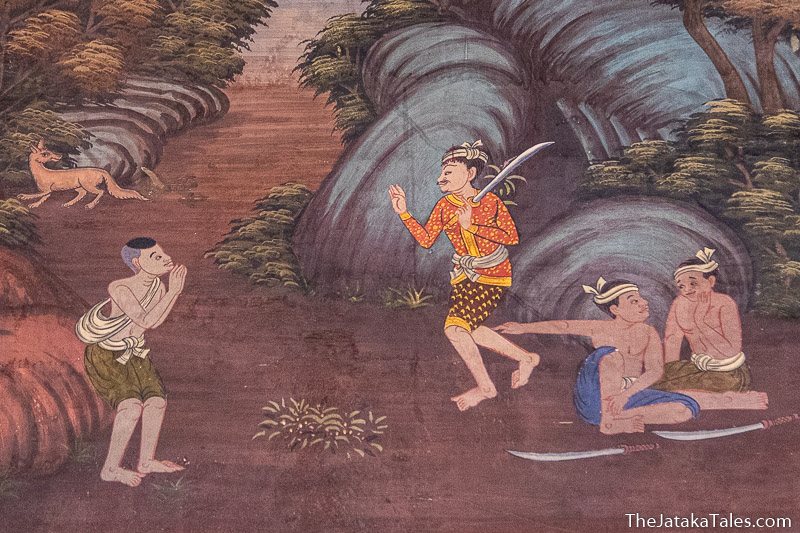
To the surprise of many, the Bodhisatta is not virtuous throughout: “Now the Bodhisattas, even though they are great beings, sometimes take the goods of others by being born as wicked men; this they say comes from a fault in the horoscope.” Some examples of his immoral behavior are rude speech (#536), hiring prostitutes (#425), gambling (#62), cannibalism (#193), adultery (#431), lying (#547), cheating (#243), theft (#318), assault (#89), owning slaves (#45), giving away his young children to work as slaves (#547), and murder (#152). He also often condones similar actions by others. And even when the Bodhisatta is perfectly righteous, the story can be a little risque, the most notable example being the very horny monkey getting into mischief in Jataka #273. Cowell and his prudish team (see About this Website) felt this Jataka tale was so improper they translated it into Latin, rather than English, so only scholars could read it. They also used Latin for a few short passages they judged offensive in other Jataka tales.
The Buddha tells his past-life stories to people for many reasons. In every Jataka tale, the past-life part is related to a present-life (i.e., the Buddha’s present) situation, some of which are entertaining stories on their own. Often the Buddha tells of his past life to teach a lesson to people or to help his disciples overcome difficulties on their quest for enlightenment. After listening to the Buddha, these people often have breakthroughs in their understanding of dharma: “His lesson ended, he preached the Truths, at the close whereof some won the First, some the Second, some the Third Path, while others again became Arahats.”1Jataka #35
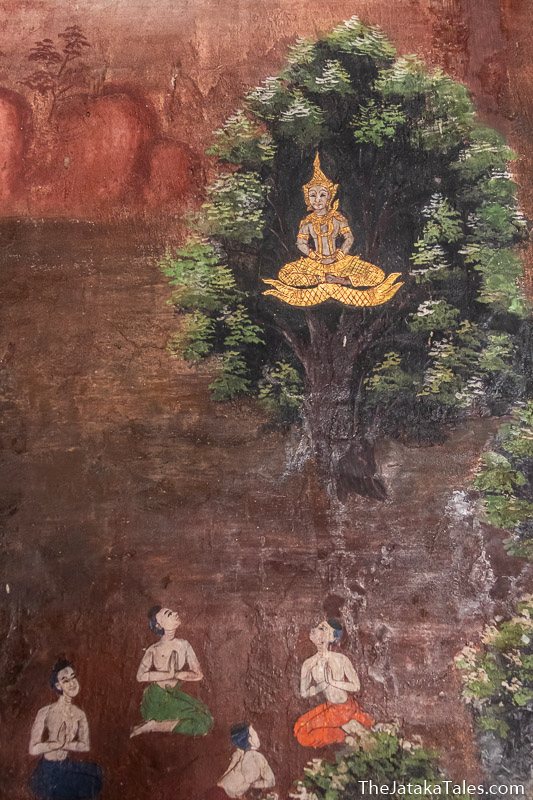
But frequently there is no educational or motivational purpose. Sometimes the Buddha tells the past-life story to remind people there is no one greater than he. In Jataka #54 some of the Buddha’s disciples were impressed by a gardener’s knowledge of fruit, so the Buddha told them he was equally skilled at this in an earlier birth. If these were not religious documents, we would say he was bragging. Other times the Buddha just tells what happened to him in the past because it is similar or related to the present situation and the people he is with enjoy hearing the stories. In Jataka #146 a group of elderly disciples loudly lamented the death of a woman who always gave them delicious food for alms. Some other disciples were shocked at their indecency, and the Buddha told them that these same men had been crows in the past and were so upset when a fish ate one of their flock they foolishly tried to empty the ocean with their beaks to rescue her.
Most of the Jataka tales appear to have been intended for regular people, but monks are clearly the intended audience for stories about things such as renunciation and the inherent wickedness of women. (While women are praised and respected in many stories, overall the Jataka tales are deeply misogynistic.) Many Jataka tales are told specifically to convince wavering monks not to leave the sangha.
Composition
Theravada Buddhism has 547 formal Jataka tales. Called the Jatakatthakatha (aka Jatakatthavannana), they are found in the Khuddaka Nikaya (“Collection of Little Texts”) collection of the Pali Canon’s Sutta Pitaka (“Basket of Discourses”) section. There is ample evidence there used to be at least five hundred fifty, but some were lost.
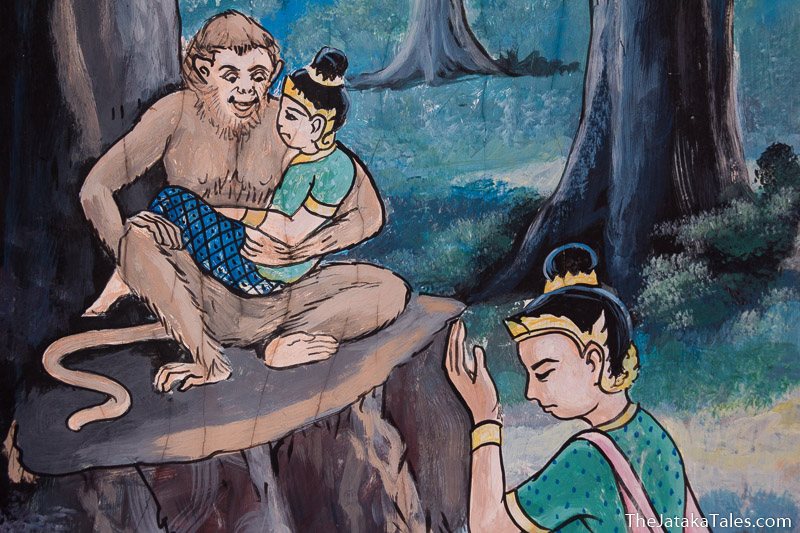
These Jataka tales do not relate all the Buddha’s past lives, just the ones he recounted to other people and were later written in this particular format. The Buddha discusses other past lives in other parts of the Pali Canon, and he tells us that, as he reached enlightenment under the Bodhi tree, he remembered hundreds of thousands of former births. Additionally, there are apocryphal Jataka that are not a part of the Pali Canon but are nonetheless considered important and “real” by many Theravadans. In Thailand, the Pannasa Jataka collection contains sixty-one apocryphal past-life stories. Also, many people consider local folktales, such as the Thai epic Ramakien and the Lao-Isan Nang Phom Hom legend, to be past-life Buddha stories.
With just a few exceptions, such as Jataka #68 (explained in the next paragraph), the Jataka tales follow the same three-part structure. The first section is a “story of the present” that details the circumstances of when, where, and, most importantly, why the Buddha tells the past-life story: “When the Brethren became aware of this, they asked the Blessed One, saying, ‘Can there be any good in this, sir?’ The Blessed One told this story of the past.”2Jataka #19 Next comes the past-life birth story itself (the actual jataka—literally “birth story” in Pali—section of the full Jataka tale), and this is usually the longest of the three sections. Then at the end of the story, the Buddha reveals who the various people in the past life are now: “His lesson ended, the Master shewed the connexion, and identified the Birth by saying, ‘Ananda was the king of those days, Sariputta the knight, and I myself the thorough-bred Sindh horse.'”3Jataka #23 The person listening to the Buddha tell the past-life story is often one of the people in it.
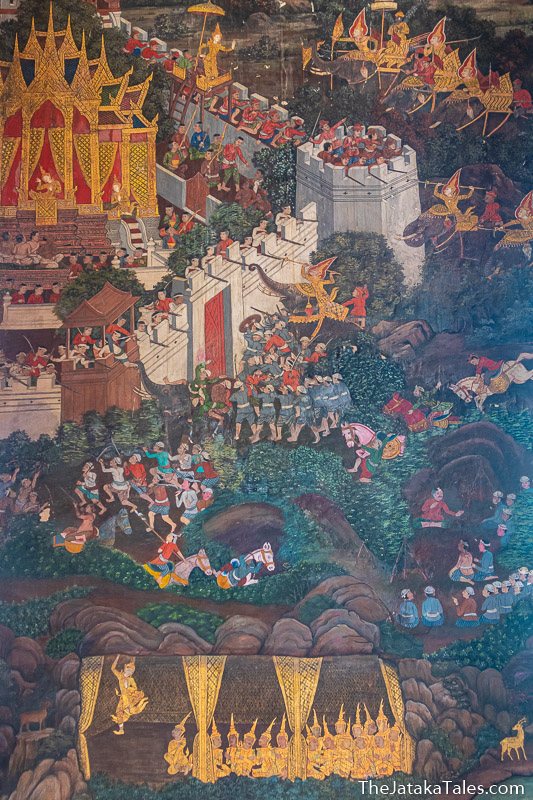
The 547 past-life stories do not report only 547 past lives. There are actually about 3,500 total past lives in the whole collection, though the exact number cannot be known. The total is much higher than 547 because some Jataka tales discuss more than one past life, notably Jataka #68 in which the Buddha mentions three thousand past lives. On the other hand, many particular past lives are recounted in more than one Jataka tale.4Past-Life Duplicates
In my estimation, the following stories take place during the same past life.
-#8 and #462
-#28 and #88
-#30 and #286
-#42, #274, #275, #375, and #395
-#46 and #268
-#52 and #539
-#57 and #224
-#68 and #237
-#82, #104, #369, and #439
-#86, #290 and #330
-#90 and #363
-#96 and #132
-#99 and #101
-#102 and #217
-#110, #111, #112, #170, #192, #350, #364, #452, #471, #500, #508, #517, and #546
-#147 and #297
-#173 and #250
-#249 and #365
-#263 and #507
-#264 and #489
-#282, #303, #351, and #355
-#283 and #492
-#328 and #443
-#346 and #405
-#367 and #368
-#371 and #428
-#429 and #430
-#441 and #545
-#470 and #535
-#502 and #534
Multiple Lives
The following stories contain more than one past life. I did not count instances where the only mention is saying that the Bodhisatta was reborn in heaven; the story needed to tell something, however small, about his time there.
-#31 contains 2 lives
-#68 contains 3,000 lives
-#134 contains 2 lives
-#135 contains 2 lives
-#136 contains 2 lives
-#159 contains 2 lives
-#291 contains 2 lives
-#415 contains 2 lives
-#421 contains 2 lives
-#449 contains 2 lives
-#450 contains 2 lives
-#458 contains 2 lives
-#468 contains 2 lives (It is unclear how many lives are discussed. When the king talks about his bad behavior in the past, he is likely discussing a single life, but these events could have happened over several lifetimes.)
-#498 contains 4 lives
-#506 contains 2 lives
-#524 contains 2 lives
-#531 contains 2 lives
-#535 contains 2 lives
-#536 contains 6 lives (Nine lives in total, but three are also told as their own Jataka tales.)
-#538 contains 4 lives
-#541 contains 2 lives (Three lives in total, but one is also told as its own Jataka.)
-#547 contains 2 lives Sometimes these are undoubtedly the exact same lifetime: Jataka #8 tells us, “In this Jataka both the Introductory Story and the Story of the Past will be given in the Eleventh Book in connexion with the Samvara-jataka;—the incidents are the same both for that Jataka and for this, but the stanzas are different,” and Jataka #170 in its entirety reads, “This Kakantaka Birth will be given below in the Maha-Ummagga Birth.” But most are not so clear cut and it can only be said that several past lives seem to be recounted in more than one Jataka tale. The ancient texts do not address the matter, so there is no way to know for certain if these apparent duplicates are actually the same life told more than once or if they are different lives that just happen to have had the same circumstances. Removing the religious element of the Jataka tales, stories such as these obviously share an earlier origin and are told differently by various storytellers or by the same storyteller at different times. Clear examples of this are Jataka #372 and Jataka #410, which tell identical stories of an ascetic adopting an orphaned animal and treating it as a child, then later becoming depressed when the animal dies. The only notable difference is that in the first it was a deer and in the second it was an elephant.
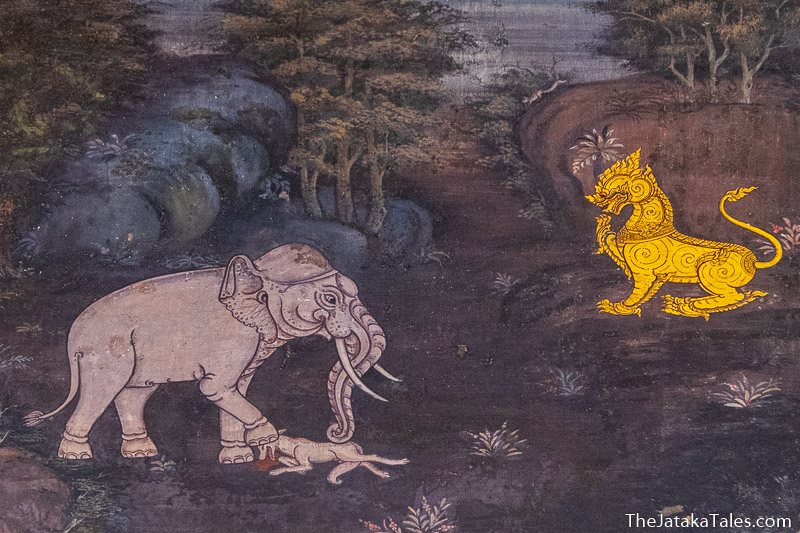
Some of these similar life stories have the exact same plot, such as the monkey who dressed up as an ascetic hoping to get out of the rain in Jataka #173 and Jataka #250, the only differences being in the narration. But duplicate lives do not always mean duplicate stories. Sometimes two Jatakas telling the same past life focus on different events, such as a man and woman married against their will who live together as celibate ascetics in Jataka #443 (the Bodhisatta did not get angry when the king abducted his wife into his harem) and Jataka #328 (he showed no sorrow when she died). And some same-life stories include details not found in their matching Jatakas, like the man being executed for breaking into the royal park to steal safflower for his wife: Jataka #297 tells us he sent a crow to give a final message to his wife, but this is not mentioned in Jataka #147. Other past-life pairs, however, while being mostly the same, have significant differences, such as when some caravan workers ignored the Bodhisatta’s instructions and ate a poisonous fruit (in Jataka #54 they all recovered, but in Jataka #85 some of the men died) and the jackal working as a lion’s servant who dies trying to kill an elephant (in Jataka #143 the two hunted as a team, the jackal being a scout and finding the food that the lion went to kill, and in Jataka #335 the jackal just stays at home and eats leftovers).
Though it is unrelated to the number of past lives, there is also a lot of repetition on the other side of the timeline. Often more than one past-life story is told regarding the same event that happened during the Buddha’s life, such as the Buddha rebuking disciples who pestered laypeople to help them build new quarters in Jataka #253, Jataka #323, and Jataka #403, and the eleven stories told in relation to the Buddha’s Great Renunciation, the beginning of his path to enlightenment.
Mahanipata Jataka
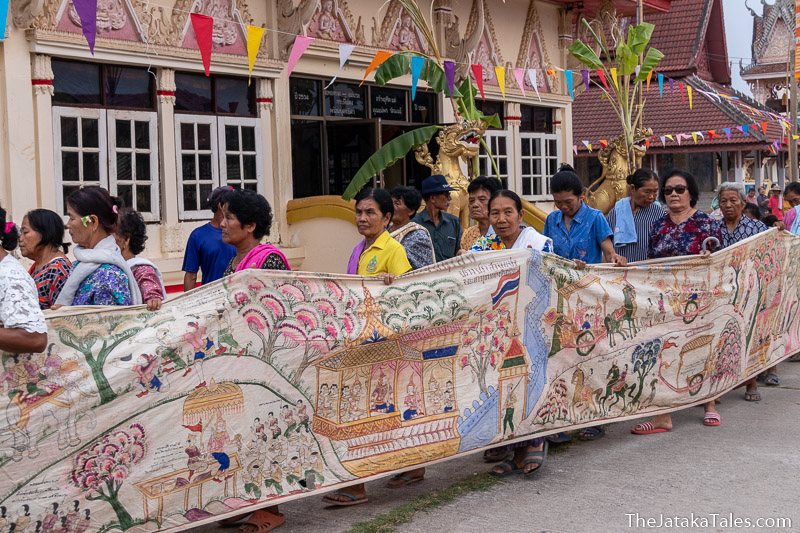
The last ten Jataka tales form a chapter called the Mahanipata, and thus are sometimes referred to as the Mahanipata Jataka. They get special attention from most Buddhists, especially in Southeast Asia. Sometimes called the “Ten Great Birth Stories of the Buddha,” these long (from about 6,000 to 47,000 words in English) stories tell the ten earthly lives that preceded his final life in which he finally became the Buddha. (They are frequently misidentified as the final ten lives of the Buddha.) Each of the stories illustrates one of the ten paramitas (“perfections of character”) (#538 renunciation/nekkhamma, #539 endurance/viriya, #540 loving-kindness/metta, #541 determination/adhitthana, #542 patience/khanti, #543 virtue/sila, #544 equanimity/upekkha, #545 truthfulness/sacca, #546 wisdom/panna, and #547 generosity/dana) that need to be developed before one can become enlightened. And while total mastery is required for Buddhahood, they are also achievable moral goals for regular people to aspire to.
Paintings and relief sculptures of these final ten stories are common in Buddhist temples around the world. Typically there is a single panel for each of the ten, and often a series telling the Vessantara Jataka (#547), the Buddha’s penultimate life: frequently there are both. The Vessantara Jataka’s moral perfection is generosity, and by extension nonattachment; the latter being the most important principle of dharma. Listening to monks recite the story is an annual event around Thailand and Laos, plus parts of Cambodia and Myanmar. It is practiced most keenly in Thailand’s Isan region and neighboring Laos where it is part of a multi-day celebration (called boon pha wet) that usually includes a parade with a long scroll depicting the whole story and costumed locals acting out parts of it around the village.
Mural Paintings Of The Last Ten Jataka
Origins
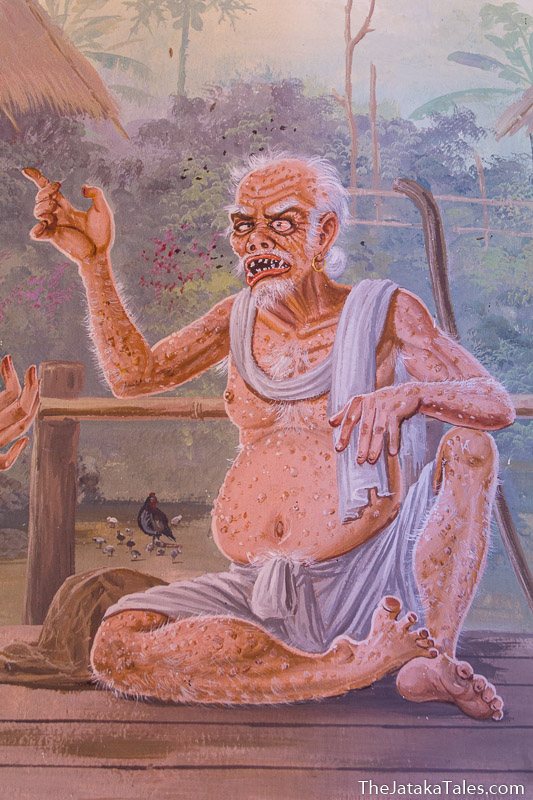
It is not known when the Jataka tales were created. Some seem to have originated as far back as the 5th century BCE (religious tradition says the Buddha was born in either 623 BCE or 563 BCE; historians can only say that in or around the 5th century BCE seems most likely) though as a whole, they acquired their present form around the 5th century CE. But while the Jataka tales were written long after the Buddha’s time, they are all built around gatha, which are considered by Buddhists to be the actual words of the Buddha himself:
Hearing what the young brahmin had done, the master exclaimed that a fool’s doings had caused all the mischief, and repeated this stanza: “Learn thou from him who tore green branches down, That tasks deferred are wrought in tears at last.”5Jataka #71
In most of the stories the gatha are very brief, as little as two lines, but in some of the later Jataka, they tell the majority of the past-life story. Despite supposedly being the Buddha’s words, gatha are frequently recited by characters other than the Bodhisatta or Buddha.
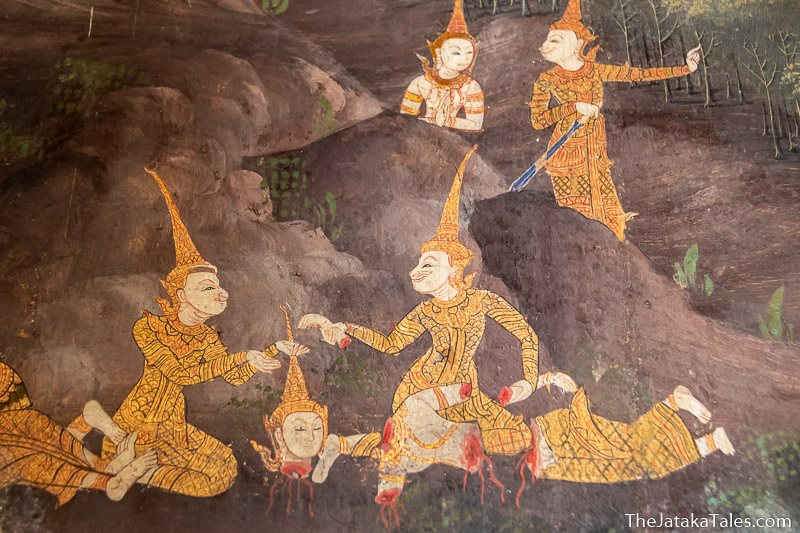
It is also not known why the Jataka tales were created. They show us there was a long, difficult path to Buddhahood, which is an important aspect of Buddhism; but they clearly were not written or compiled into a single collection in order to show the Buddha’s progression along this path. Their order is neither chronological nor in any way related to plots, lessons, or any other aspects of the stories; rather they are arranged by the number of gatha verses they contain. And, as already mentioned, in many of them the Bodhisatta neither teaches a lesson nor performs a meritorious act. Considering both their format (a mix of canon and commentary) and their content, it seems probable (to me, at least) that the main purpose was to present the Buddha’s greatness in an entertaining and relatable way. People can identify with a pre-enlightenment Bodhisatta in a way they cannot with the nearly infallible, god-like Buddha. Even today, Jataka tales are used in sermons and ceremonies, they have been made into books and videos (many produced for children), and they are as common in Buddhist temple mural paintings as scenes from the life of the Buddha.
Whether it was their intent or not, the creators of the Jataka tales did make a very entertaining collection of stories. And they appeal to all, regardless of culture or religion.
